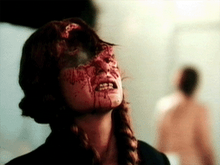If you're a person who primarily thinks of film as a storytelling medium that brings the written word to life through plot mechanics and relatable characters with understandable motivations and behaviors, Dario Argento movies will probably frustrate you. If, like me, you think that film is first, foremost, and last a visual medium, that the collision of image, performance, technique, experience, and emotion in the frame is infinitely more important than what's on the page, and that each film has its own internal dream logic so who cares if it doesn't always make real world sense, then you possibly agree with me that Dario Argento, in his peak years between the early 1970s and late 1980s, was one of the great visual stylists and that his strongest movies are a near-constant delight for the eyeballs.
Deep Red, like most of that stretch of Argento from 1970's The Bird with the Crystal Plumage to 1987's Opera, is full of rich, deep colors, ridiculously powerful images, graceful and unpredictable camera movements, especially in POV shots (though Argento is also down to get rough and graceless for maximum effect), gorgeous (or gorgeously garish) set and costume design, a wildly memorable score, refreshingly illogical character behavior, violent murders that are simultaneously brutal and beautiful in their choreography, and a frame that never shows you anything pedestrian or boring simply to move the plot along. Every single person, place, and thing onscreen is of maximum visual interest, even the bathroom tile. When an image veers too close to conventionality or repetition, Argento simply amps up the heavy baroque prog funk of Goblin on the soundtrack to keep it sassy. Each time I watch it, I get less and less interested in the murder mystery at its center and more and more thrilled by its style, technique, and momentum.
The relatively silly plot contains some of the standard traits of the Italian giallo — a black-gloved killer in a trench coat, an ex-pat eyewitness to one of the murders who becomes obsessed with solving the case, violently elaborate deaths, and useless cops — but I never get tired of these old standards, and, anyway, Argento is just using them as the hanger for a pretty spectacular outfit. (I heard some people think anything using an em-dash is automatically AI, but I was using the em-dash when AI was in short pants, son. This post was not written by AI, but it was written by a.i. (an idiot).)
Blow-Up's David Hemmings stars as Marcus Daly, a British pianist teaching at a conservatory in Rome. While walking the strangely isolated streets near his apartment, Marcus stops to chat with a fellow pianist, Carlo (Gabriele Lavia), who is a drunken mess. He's downing drinks on the street outside the Edward Hopper-esque Blue Bar and engaging in a self-pity session about having to scrounge for gigs while his friend teaches at the conservatory. A horrible scream interrupts the conversation, startling both men. Not seeing anything, Carlo shuffles back to his drinking spot, but Marcus takes a second look toward the window of his apartment building and catches part of the murder of the woman who rents the apartment below his, a Lithuanian psychic named Helga Ullmann (Macha Meril). Marcus rushes into the building to help but is too late.
While being held in the apartment for questioning, Marcus meets eccentric, free-spirited journalist Gianna Brezzi (Daria Nicolodi). Gianna and Marcus develop a friendship/friendship with benefits/rivalry/rivalry with benefits, and the two become a sort of comedic odd couple trying to beat each other at solving the murder. Nicolodi is always great in her then-partner Argento's movies (and she wrote one of his best, Suspiria), but her performance here is probably my favorite of the batch. I love the scene of her driving him around in her rapidly deteriorating car, and the scene where she beats him twice at arm wrestling (called "Indian wrestling" here for some reason) after he talks shit about women's lib.
The rest of the movie contains several classic Argento setpieces, Marcus the pianist's reckless disregard for his own hands, improper handling of material in libraries and archives (my archivist/librarian/records manager wife was not a fan of this), loud birds, weird dolls (including a mechanical one), great architecture, bold eye makeup, artistically satisfying mega-violence, and memorable appearances from Clara Calamai as Carlo's oddball ex-actress mother, redheaded child star of multiple '70s Italian horror films Nicoletta Elmi playing another really weird kid, and Geraldine Hooper, an androgynous woman who further plays with gender fluidity here in her performance as an androgynous man.
A side tangent: Argento doesn't get enough credit (and was incorrectly labeled a homophobe by centrist liberals whose goal is mainstream respectability and performative uplift) for his films' use of gay, bisexual, gender-fluid, and trans characters, even when they're a bit exaggerated (the gay private detective in Four Flies on Grey Velvet is so over the top he was criticized as a stereotype by some critics, but he's presented as one of the most likable, honest, and life-filled characters in the movie). Even when he misses the mark a bit, I get the impression Argento's portrayal of these characters is coming from a place of genuine curiosity and relaxed acceptance.
Deep Red is top-tier Argento for me. I'm in love with the look of this thing from start to finish. Even if you're a plot-based person, I think you'll at least say "that was cool" a minimum of six times per viewing. It's just so satisfying to watch a scene and think, "I love the colors. I love the clothes. I love the makeup. I love the damn bathroom tile. I love the way the camera moves. I love the music. I love the construction of the shot. I love the wide shots. I love the closeups. I love the way the scene builds. I love the juxtaposition of this shot and that shot. I love everything I'm seeing and hearing right now." People used to make stuff like this. Okay, one guy used to make stuff like this. With a couple dozen notable exceptions each year, where have all the good times gone?











No comments:
Post a Comment